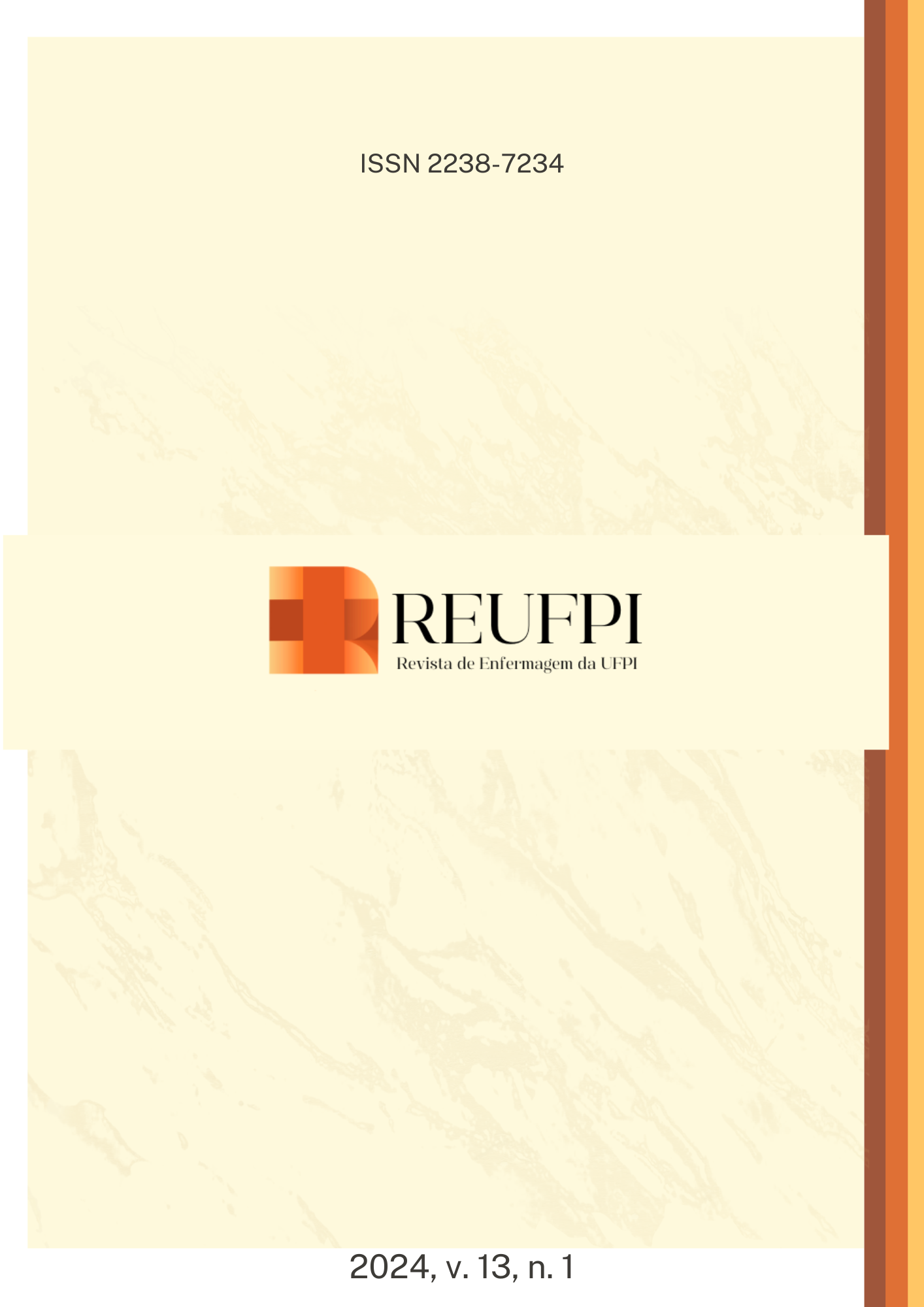Palliative care for people with neoplastic wounds: perceptions and practices of the nursing team
DOI:
https://doi.org/10.26694/reufpi.v13i1.4420Palavras-chave:
Wounds and Injuries, Nursing, Palliative Care, Neoplasms, Nursing Care, Oncology NursingResumo
Objective: To understand the perceptions and practices of the nursing team in assisting people in palliative care with neoplastic wounds. Method: A descriptive study with a qualitative approach, carried out with 12 nursing professionals working in a Level II High Complexity Oncology Hospital, located in the interior of Minas Gerais, Brazil, in 2022. Data was collected through semi-structured interviews and analyzed according to the method proposed by Bardin. Results: Three thematic categories emerged: Nursing care that transcends the management of neoplastic wounds; The role of the nursing team in the assessment and care of neoplastic wounds; and Feelings that involve nursing professionals in the context of palliative care. Conclusion: It is essential to approach the person holistically. The management of neoplastic wounds has its own particularities, since pain is a symptom that usually accompanies the lesion, in addition to the odor and discomfort that the person and their family may feel. Palliative care is relevant to help manage the symptoms of these lesions. Workers often experience feelings such as anguish, fear, sadness and frustration.
Referências
Ministério da Saúde (BR). Gabinete do Ministro/Comissão Intergestores Tripartite. Resolução nº 41, de 31 de outubro de 2018. Dispõe sobre as diretrizes para a organização dos cuidados paliativos, à luz dos cuidados continuados integrados, no âmbito Sistema Único de Saúde (SUS). Diário Oficial da União: edição 225, seção 1, página 276, Basília, DF, 31 out. 2018. Disponível em: <https://in.gov.br/web/guest/materia/-/asset_publisher/Kujrw0TZC2Mb/content/id/51520746/do1-2018-11-23-resolucao-n-41-de-31-de-outubro-de-2018-51520710>. Acesso em: 20 abr. 2022.
Melo CF et al. O binômio morte e vida para idosos em cuidados paliativos. Rev. SPAGESP, [Internet] Ribeirão Preto, v. 22, n. 2, p. 5-18, dez. 2021. Disponível em: <http://pepsic.bvsalud.org/scielo.php?script=sci_arttext&pid=S1677-29702021000200002&lng=pt&nrm=iso>. Acesso em: 21 abr. 2022.
Oliveira SX et al. Enfrentamento emocional de enfermeiros cuidadores de pacientes oncológicos. Rev. Ciênc. Méd. Biol, [s.l], v. 20, n. 1, p. 83-88, mai. 2021. doi: http://dx.doi.org/10.9771/cmbio.v20i1.37904
Silva TC, Nietsche EA, Cogo SB. Palliative care in Primary Health Care: an integrative literature review. Rev. bras. enferm., [s.l], v. 75, n. 1, 2022. doi: https://doi.org/10.1590/0034-7167-2020-1335
Souza TJ et al. Nurses conduct in palliative care: an integrative review. Nursing (Ed. brasileira. Online), São Paulo, v. 24, n. 280, p. 6211-6220, set. 2021. doi: https://doi.org/10.36489/nursing.2021v24i280p6000
Soares RS, Cunha DAO, Fully PSC. Nursing care with neoplastic wounds. Rev. enferm. UFPE on line., [s.l], v.12, n. 12, p. 3456-3463, dez. 2018. doi: https://doi.org/10.5205/1981-8963-v01i01a236438p3456-3463-2019
Ministério da Saúde (BR). Instituto Nacional de Câncer José de Alencar Gomes da Silva (INCA). Tratamento e controle de feridas tumorais e úlceras por pressão no câncer avançado: série cuidados paliativos. Rio de Janeiro: INCA, 2009. Disponível em: <https://bvsms.saude.gov.br/bvs/publicacoes/inca/Feridas_Tumorais.pdf>. Acesso em: 20 abr. 2022.
Ramirez-Elias A, Arbesu-Garcia MI. El objeto de conocimiento em la investigación cualitativa: um asunto epistemológico. Enferm. univ., Ciudad de México, v. 16, n. 4, p. 424-435, dez. 2019. Disponível em: https://www.scielo.org.mx/scielo.php?script=sci_arttext&pid=S1665-70632019000400424. Acesso em: 05 fev. 2023
Tong A, Sainsbury P, Craig J. Consolidated criteria for reporting qualitative research (COREQ): a 32-item checklist for interviews and focus groups. Int J Qual Health Care. 2007;19(6):349-357.
Minayo MCS. Amostragem e saturação em pesquisa qualitativa: consensos e controvérsias. Rev. Pesqui. Qual. (Online), São Paulo, v .5, n. 7, p. 1-12, abr. 2017. Disponível em: https://editora.sepq.org.br/index.php/rpq/article/view/82/59. Acesso em: 18 abr. 2022.
Bardin L. Análise de Conteúdo. São Paulo (SP): Edições 70; 2011.
Machado MMS et al. Nursing assistance protocol for patients in terminal care: Construction through integrative review. Nursing (Ed. brasileira. Online), Säo Paulo, v. 25, n. 292, p. 8662-8673, set. 2022. doi: https://doi.org/10.36489/nursing.2022v25i291p8662-8673
Souza MOLS et al. Reflections of nursing professionals on palliative care. Rev. bioét. (Impr.)., [s.l], v. 30, n. 1, p. 162-171, jan. 2022. doi: https://doi.org/10.1590/1983-80422022301516PT
Andrade FL et al. Conhecimento de enfermeiras sobre avaliação e manejo clínico de pacientes com ferida neoplásica. Rev. Enferm. Atual In Derme., [s.l], v. 85, n. 23, p. 44-50, abr. 2019. doi:https://doi.org/10.31011/reaid-2018-v.85-n.23-art.243
Reis KMC, Jesus CAC. Impaired comfort at heend of life: na association with nursing diagnosis and clinical variables. Texto & contexto enferm., [s.l], v. 30, e20200105, 2021. doi: https://doi.org/10.1590/1980-265X-TCE-2020-0105
Herdman TH, Kamitsuru S, Lopes CT. (org.). NANDA International Nursing Diagnoses: definitions & classification - 2021-2023. New York: Thieme, 2021.
Paes TV, Silva-Rodrigues FM.; Ávila, LK. Non-pharmacological Methods for Pain Managemente in Pediatric Oncology: Evidences in Literature. Rev. Bras. Cancerol. (Online)., [s.l], v. 67, n. 2, e-031027, mar. 2021. doi: https://doi.org/10.32635/2176-9745.RBC.2021v67n2.1027
Castro RMM et. al. Utilização da aromaterapia e auriculoterapia como métodos não farmacológicos para alívio da dor em idosos. Braz J Dev, v. 6, n. 8, 60770–60787, 2020.doi: https://doi.org/10.34117/bjdv6n8-479
Nascimento NS, Santos ATN, Alves PGJM. Métodos e Técnicas Não Farmacológicos no Tratamento da Dor Oncológica: Revisão Sistemática da Literatura. Rev. Bras. Cancerol. (Online)., [s.l], v. 68, n. 4, e-172667, nov. 2022. doi: https://doi.org/10.32635/2176-9745.RBC.2022v68n4.2667
Castro MCF et al. Intervenções de enfermagem para pacientes oncológicos com odor fétido em ferida tumoral. Aquichan, [s.l], v. 17, n. 3, p. 243-256, set. 2017. doi:https://doi.org/10.5294/aqui.2017.17.3.2
Silva RM, Fernandes FAV. Wound Navigator Profiling: scoping review. Rev. gaúch. enferm., Porto Alegre, v. 40, e20180421, set. 2019 doi: https://doi.org/10.1590/1983-1447.2019.20180421
Santos E et al. The effectiveness of cleansing solutions for wound treatment: a systematic review. Referência, [s.l], v. 4, n. 9, p. 133-144, mai. 2016. doi: http://dx.doi.org/10.12707/RIV16011
Kramer A et al. Consensus on Wound Antisepsis: Update 2018. Skin Pharmacol Physiol, [s.l], dez. 2017.doi: https://doi.org/10.1159/000481545
Martínez-mejorada R. et al. Polyhexamethylene biguanide dressings in the treatment of a wound. A case report. Cir Gen., [s.l], v. 44, n. 1, p. 29-33, mar. 2022. doi: https://doi.org/10.35366/109316
Ferreira SAC. Terapia tópica para controle da dor em ferida neoplásica maligna: revisão de escopo. 2020. Dissertação (Mestrado em Ciências) - Escola de Enfermagem, Universidade de São Paulo, São Paulo, 2020. Disponível em: https://www.teses.usp.br/teses/disponiveis/7/7139/tde-24022021-150118/publico/Suzana_Ferreira.pdf. Acesso em: 24/01/23
Silva CA, Viana DFA. Principais características das feridas oncológicas. 2020. Artigo (Bacharelado em Enfermagem) -Centro Universitário do Planalto Central Apparecido dos Santos – Uniceplac, Gama, Distrito Federal, 2020. Disponível em: https://dspace.uniceplac.edu.br/bitstream/123456789/901/1/Carissa%20Aguiar%20da%20Silva_0005078%20_Dyegisla%20Fernanda%20de%20Araujo%20Viana_0005392.pdf. Acesso em: 26 jan. 2023.
Silva EVS, Conceição HN. Cuidados paliativos de enfermagem a pacientes com feridas neoplásicas. Espaç. saúde (Online), [s.l], v. 21, n. 1, p. 82-94, jul. 2020. doi: https://doi.org/10.22421/15177130-2020v21n1p82
Fontes FLL, Oliveira AC. Competências do enfermeiro frente à avaliação e ao tratamento de feridas oncológicas. Rev. Uningá [Internet]. 2019;56(S2):71-9. doi: https://doi.org/10.46311/2318-0579.56.eUJ2158
Souza NR et al. Prescription and use of metronidazole for the control of odor in neoplastic wounds. Cogitare Enferm. (Online), [s.l], v. 24, e57906, 2019. doi: http://dx.doi.org/10.5380/ce.v24i0.57906
Narciso AC et al. Variables associated with neoplastic wound odor control: knowledge for nursing care. Rev. Enferm. UERJ (Online), [s.l], v. 25, e26036, dez. 2017.doi: https://doi.org/10.12957/reuerj.2017.26036
Souza MAO et al. Odor evaluation scales for odor in neoplastic wounds: na integrative review. Rev. bras. enferm., [s.l], v. 71, n. 5, p. 2552-2560, oct. 2018. doi: http://dx.doi.org/10.1590/0034-7167-2017-0428
Soares WTSM et al. Nurses’ feeling facing patient in na intensive care unit. Rev. Pesqui. (Univ. Fed. Estado Rio J., Online), [s.l], v. 14, p. 9794-9802, 2022. doi: https://doi.org/10.9789/2175-5361.rpcfo.v14.9794
Trainoti PB et al. To palliate, caring beyond pain: a reflection of health professionals in pediatric oncology. Rev. bras. promoç. saúde (Online), [s.l], v. 35, n. 11, set. 2022. doi: https://doi.org/10.5020/18061230.2022.12308
Duarte MLC et al. Pleasure and suffering in the work of nurses at the oncopediatric hospital unit: qualitative research. Rev. bras. enferm., [s.l], v. 74, n. 3, mai. 2021.doi: https://doi.org/10.1590/0034-7167-2020-0735
Rodrigues MSD et al. Compassion fatigue in nursing professionals in the context of palliative care: scoping review. REME rev. min. enferm., Belo Horizonte, v. 25, e-1386, set. 2021. doi: http://dx.doi.org/10.5935/1415.2762.20210034
Downloads
Publicado
Como Citar
Edição
Seção
Licença
Copyright (c) 2024 Rev Enferm UFPI

Este trabalho está licenciado sob uma licença Creative Commons Attribution 4.0 International License.
Autores mantém os direitos autorais e concedem à REUFPI o direito de primeira publicação, com o trabalho licenciado sob a Licença Creative Commons Attibution BY 4.0 que permite o compartilhamento do trabalho com reconhecimento da autoria e publicação inicial nesta revista.






